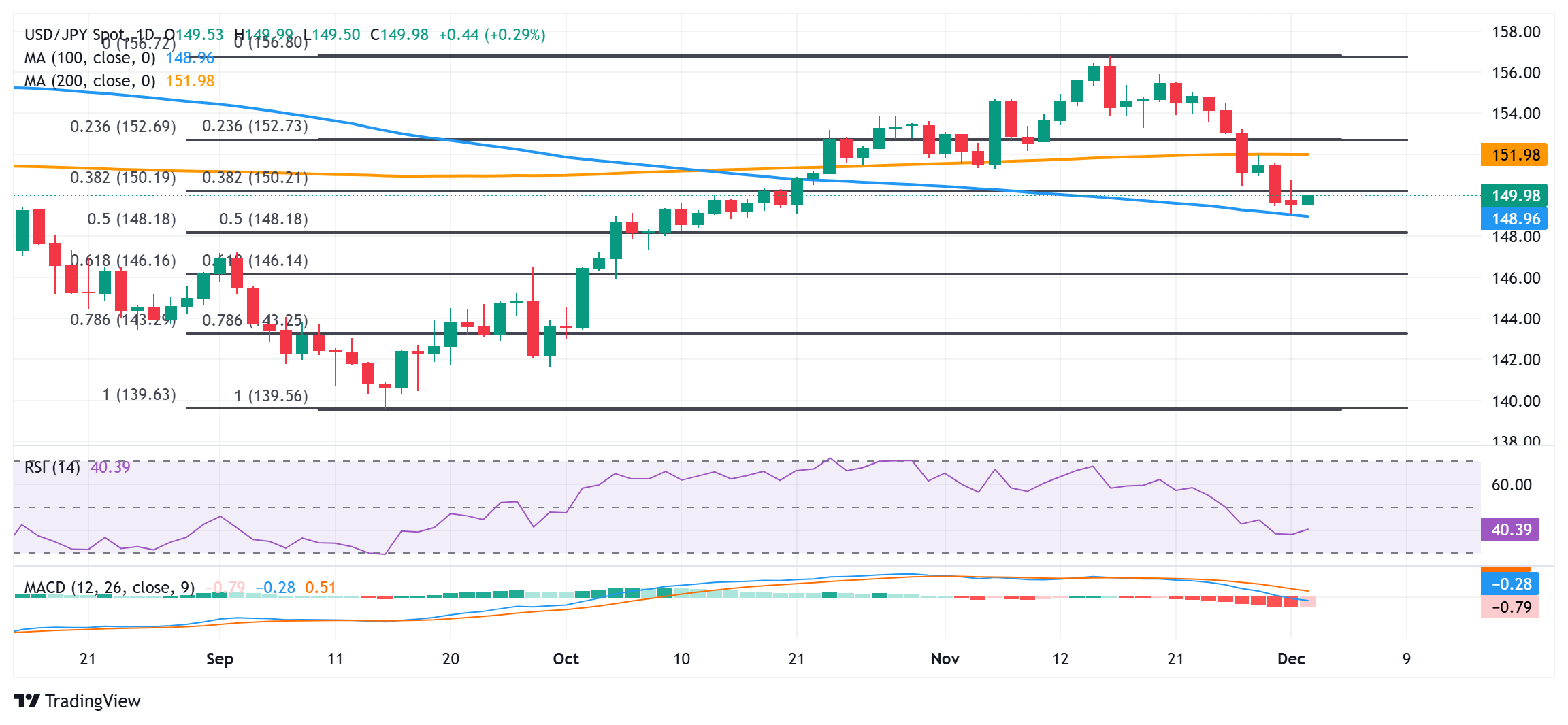- The Japanese Yen attracts some sellers on Tuesday, although it lacks follow-through.
- Rising expectations of another BoJ rate hike in December help limit the JPY’s decline.
- Geopolitical risks, Trump’s tariff threats and suppressed US bond yields favor JPY bulls.
The Japanese Yen (JPY) moves lower against its US counterpart during the Asian session on Tuesday and moves the USD/JPY pair away from the lowest level since October 16 touched the previous day. However, speculation that the Bank of Japan (BoJ) could raise interest rates again in December should limit any significant JPY depreciation. In addition to this, looming trade tariff threats from US President-elect Donald Trump, along with lingering geopolitical risks, could benefit the JPY as a safe haven.
Meanwhile, the recent drop in US Treasury yields does not help the US Dollar (USD) capitalize on the overnight rebound from a multi-month low and could offer further support to the lower-yielding JPY. This, in turn, justifies some caution before opening aggressive bullish bets on the USD/JPY pair. Additionally, traders could also choose to wait for more clues on the Federal Reserve’s (Fed) rate cut path. Therefore, this week’s crucial US macroeconomic data will boost the USD and provide fresh impetus to the currency pair.
Japanese Yen bulls have the upper hand amid BoJ December rate hike expectations
- The Tokyo Consumer Price Index (CPI) for November, released last week, suggested that core inflation is gaining momentum and raised expectations for a December rate hike by the Bank of Japan.
- BoJ Governor Kazuo Ueda said on Saturday that the central bank will adjust the degree of monetary easing at the appropriate time if it becomes certain that core inflation rises towards 2%.
- Russia fires at least 60 North Korean missiles at Ukraine. North Korean leader Kim Jong Un has vowed that his country will unswervingly support Moscow until Russia achieves a major victory in Ukraine.
- US President-elect Donald Trump has pledged to impose large tariffs against the United States’ three largest trading partners and the ‘BRICS’ nations, raising the risk of a second wave of a global trade war.
- Investors remain concerned that Trump’s tariff plans and expansionary policies will reignite inflationary pressures and force the Federal Reserve to stop cutting rates or possibly raise them again.
- The Institute of Supply Management’s (ISM) Manufacturing Purchasing Managers’ Index (PMI) rose to 48.4 in November amid hopes for business-friendly policies from the Trump administration.
- According to the CME Group’s FedWatch tool, traders are currently pricing in nearly 75% the chance that the US central bank will cut borrowing costs again by 25 basis points later this month.
- The yield on the 10-year US Treasury bond had fallen to its lowest levels since late October, narrowing the yield differential between the US and Japan, which should also benefit the lower-yielding Japanese Yen.
- Investors are eagerly awaiting major US macroeconomic releases scheduled for the start of a new month for more clues on the Fed’s future rate cut path, which will influence the USD and the USD/JPY pair.
USD/JPY could attract new sellers at higher levels and remain capped near 151.00
From a technical perspective, last week’s break below the 38.2% Fibonacci retracement level of the September-November rally could be seen as a new trigger for bearish traders. Furthermore, the oscillators on the daily chart remain deep in negative territory and are still far from being in the oversold zone, suggesting that the path of least resistance for the USD/JPY pair remains to the downside. That said, a modest rebound from the 100-day SMA support, currently situated near the 149.00 level, warrants some caution before positioning for deeper losses. A convincing break below that level should pave the way for a decline towards the 50% retracement level, around the 148.20 region en route towards the 148.00 level. Some continuation selling could expose the 61.8% Fibonacci level, around the round figure of 147.00, with some intermediate support near the 147.35 area.
On the contrary, further strength beyond the psychological level of 150.00 now appears to face strong resistance near the overnight high, around the 150.75 region, before the round figure of 151.00. Sustained strength beyond the latter could trigger a short-covering rally and lift the USD/JPY pair towards the 151.65 region en route towards the 152.00 level. The latter represents the very important 200-day SMA and should act as a key pivot point, which if broken decisively, will suggest that the recent corrective pullback from a multi-month high has come to an end. This, in turn, would shift the short-term bias in favor of bullish traders.
The Japanese Yen FAQs
The Japanese Yen (JPY) is one of the most traded currencies in the world. Its value is determined broadly by the performance of the Japanese economy, but more specifically by the policy of the Bank of Japan, the differential between the yields of Japanese and US bonds or the risk sentiment among traders, among other factors.
One of the mandates of the Bank of Japan is currency control, so its movements are key for the Yen. The BoJ has intervened directly in currency markets on occasion, usually to lower the value of the Yen, although it often refrains from doing so due to the political concerns of its major trading partners. The BoJ’s current ultra-loose monetary policy, based on massive stimulus to the economy, has caused the depreciation of the Yen against its main currency pairs. This process has been exacerbated more recently by a growing policy divergence between the Bank of Japan and other major central banks, which have opted to sharply raise interest rates to combat decades-old levels of inflation.
The Bank of Japan’s ultra-loose monetary policy stance has led to increased policy divergence with other central banks, particularly the US Federal Reserve. This favors the widening of the spread between US and Japanese 10-year bonds, which favors the Dollar against the Yen.
The Japanese Yen is often considered a safe haven investment. This means that in times of market stress, investors are more likely to put their money in the Japanese currency due to its supposed reliability and stability. In turbulent times, the Yen is likely to appreciate against other currencies that are considered riskier to invest in.
Source: Fx Street
I am Joshua Winder, a senior-level journalist and editor at World Stock Market. I specialize in covering news related to the stock market and economic trends. With more than 8 years of experience in this field, I have become an expert in financial reporting.








